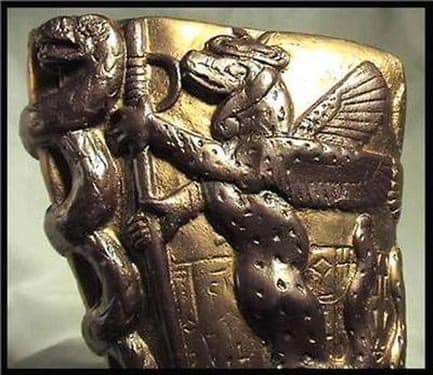DRAGON GRAIL CUP OF SUMER

DRAGON GRAIL CUP OF SUMER
„A rare workshop casting of a relief impression from the ritual Libation Cup of King Gudea of Lagash from around 2100 BC. The relief portrays a unique depiction of the ancient Sumerian lion-serpent-dragon Tiamat, standing guard over the terrestrial Tree Of Life, which is entwined with a serpent. The image is repeated on both sides of the original cup, forming one of the oldest known images of the snake and the caduceus.”
„The votive chalice was a favourite possession of King Gudea, who ruled the Mesopotamian city of Lagash from 2141 to 2122 BC. However the cup itself has been dated to as early as 4000 BC, which would explain the archaic Sumerian iconography and perhaps, the earliest known depiction of the Dragon in Indo-European history. The cuneiform inscription reads:
„To the god Ningizzida, his god Gudea, patesi of Lagash, for the prolongation of his life, has dedicated this.”
It is said that Ningizzida is identified with the star goddess Ishtar, who is also identified with the celestial Dragon Tiamat and often pictured with a caduceus of serpents climbing the tree of life.”
http://trianglebook.50megs.com/whats_new_12.html…
„The name Sumerian is related to the root „Sumaire,” meaning Dragon, whilst the name „Scythian” specifically means both „prince” and „power.” Both peoples were originally, essentially the same and in antiquity – prior to the Biblical Flood – they occupied the regions north of the Black Sea now known as Transylvania and Carpathia.” ~ The Dragon Cede, de Vere and Hunter.
KUBEK SMOKA GRAALA LETNIEGO
„Rzadki warsztatowy odlew płaskorzeźby z rytualnego Pucharu Libacji króla Gudei z Lagasz z około 2100 rpne Relief przedstawia unikalny wizerunek starożytnego sumeryjskiego smoka-węża-lwa Tiamat, stojącego na straży ziemskiego Drzewa Życia, który jest spleciony z wężem. Obraz jest powtórzony po obu stronach oryginalnego kielicha, tworząc jeden z najstarszych znanych wizerunków węża i kaduceusza.” Kielich wotywny był ulubioną własnością króla Gudei, który rządził mezopotamskim miastem Lagasz od 2141 do 2122 pne. Jednak sam kielich datuje się już na 4000 pne, co wyjaśnia archaiczną ikonografię sumeryjską i być może najwcześniejsze znane przedstawienie smoka w historii Indoeuropejskiej, napis pismem klinowym brzmi: „Bóg Ningizzida, jego bóg Gudea, patesi z Lagasz, zadedykował to dla przedłużenia swego życia”. Mówi się, że Ningizzida jest utożsamiana z boginią gwiazd Isztar, która jest również utożsamiana z niebiańskim smokiem Tiamat i często przedstawiana z kaduceuszem węży wspinającym się na drzewo życia.
http://trianglebook.50megs.com/whats_new_12.html…
„Nazwa Sumerowie jest spokrewniona z rdzeniem „Sumaire”, co oznacza Smoka, podczas gdy imię „Scytyjski” konkretnie oznacza zarówno „książę”, jak i „moc”. Oba ludy były pierwotnie, zasadniczo takie same i w starożytności – przed biblijnym potopem – zajmowały regiony na północ od Morza Czarnego znane obecnie jako Transylwania i Karpatia”. ~ Smocza Cede, de Vere i Hunter.
https://www.facebook.com/Scythian-Dragon-Empire-II-2309238812642987/photos/a.2348970222003179/3319768441590014

